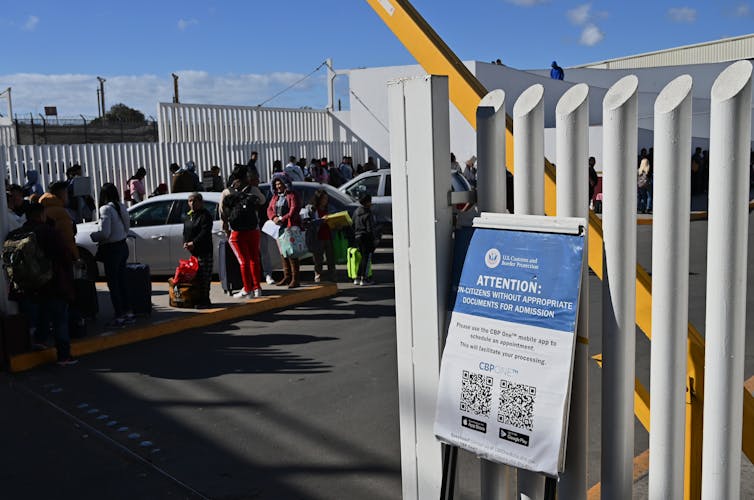
Paula Connelly/iStock via Getty Images Plus
David Acunzo, University of Virginia
We’ve all seen it, typically on television or on stage: A hypnotist selects a few members from the audience, and with what seems to be little more than a steely stare or a few choice words, they’re suddenly “under the spell.” Depending on what the hypnotist suggests, the participants laugh, dance and perform without inhibition.
Or perhaps you’ve experienced hypnosis another way – with a trip to a hypnotherapist for a series of sessions to help you stop smoking, lose weight, manage pain or deal with depression. This is no longer unusual; thousands of Americans have done the same thing. And many were helped.
Hypnosis has been found to be effective for treating irritable bowel syndrome, and it may be beneficial for weight reduction, sleep disorders and anxiety. For mild to moderate depression in adults, hypnotherapy is as effective as cognitive behavioral therapy, and it can help with depression in children. Hypnosis is also used to treat phobias, PTSD and to control pain during surgery and dental procedures in both adults and children.
Yet despite the evidence, its widespread use and its growing popularity, hypnosis is still viewed with skepticism by some scientists, and with curiosity by much of the public. As a researcher studying altered states from a cognitive and neuroscientific perspective, I’m happy to help pull back the curtain to show you how hypnosis works.

PeopleImages/iStock via Getty Images Plus
A hypnotherapy session
In simple terms, hypnosis is a procedure that helps people imagine different experiences that feel very real. When that occurs, the person can be said to be in a state of hypnosis.
Little is known about what characterizes a hypnotic state in terms of brain activity, but neuroimaging studies indicate a decrease in activity in the parts of the brain responsible for self-referential thought and daydreaming, and increased links between the parts responsible for attention and action.
These results are consistent with the idea that people who are hypnotized are in a state that inhibits internal thoughts and other distractions, such as bodily sensations or noises, that may interfere with the hypnosis.
A therapist’s first set of suggestions typically includes the “hypnotic induction,” which helps the subject increase their responsiveness to other suggestions. An induction may be like this: “I will now count from 5 to 1. At every count, you will feel even more relaxed, and that you are going deeper and deeper into hypnosis.”
When responding to suggestions, the subject’s experience feels involuntary. That is, it’s happening to them, rather than generated by them. This is known as the classical suggestion effect. Following a suggestion to move their arm, the subject may feel as though their arm rises on its own, rather than being raised of their own volition.
For perceptual suggestions, the experience can feel quite real and distinct from voluntary imagination. If I ask you to imagine hearing a dog barking outside, it requires an effort, and the experience does not feel like there’s really a dog barking outside. But through hypnotic suggestion, responsive subjects will feel like they hear a dog barking, and they won’t be cognizant of any effort to make it happen.
What makes people hypnotizable?
You can’t force anyone to be hypnotized. Willingness to participate, a positive attitude, motivation and expectation are hugely important. So is the ability to set aside the fact that the situation is imaginative. It’s like when you become fully absorbed with the story and characters in a movie – so absorbed you forget you’re in a theater.
Good rapport with the therapist is also critical. If you refuse to cooperate or decide hypnosis won’t work, it won’t. A good comparison may be meditation: You can listen to a meditation recording, but if you’re unwilling to follow the instructions, or if you’re unmotivated or distracted, it won’t have any effect.
Few traits predict whether someone is easily hypnotizable, but people are not equal in their ability to respond to hypnotic suggestions. Some people vividly experience a wide array of suggestions; others, not nearly as much. There are indications that women respond slightly better to hypnotic suggestions than men, and that peak hypnotizability occurs during late childhood and early teenage years.
From a neuroscientific perspective, it appears that hypnotic suggestions do not act directly on our executive functions, but rather on our self-monitoring functions. That is, hypnosis does not directly decide our behaviors for us. Rather, it modifies how the brain monitors what it’s doing. So when the hypnotist suggests that you raise your arm, you’re still the one making that decision – although your experience may seem like the arm is moving by itself.

Exposure therapy, self-hypnosis
The aim of hypnotherapy is to induce changes in negative emotions, perceptions and actions. Suppose you are afraid of public speaking. Through suggestions, the therapist may make you go through the experience of talking in front of an audience. Again, it feels real – your stress level will rise, but ultimately you’ll habituate yourself and learn to cope with the stress, even as the therapist suggests increasingly challenging scenarios.
Hypnosis can also be used as a preparation or replacement for exposure therapy, which is a method to treat phobias or anxiety related to specific situations by progressively exposing the patient to increasingly challenging situations. If you’re afraid of birds, the therapist may suggest you imagine holding a feather; then imagine getting near a bird in a cage; then imagine going to the park and feeding pigeons. This is more effective, and feels more real, than mere visualization.
The hypnotherapist can also teach self-hypnosis techniques. Subjects can learn to induce a state of relaxation that’s associated with a gesture, such as closing the left hand.
Hypnotic suggestions like this decrease anxiety by promoting activation of the parasympathetic nervous system, which stimulates bodily functions during times of rest, such as digestion and sexual arousal, and deactivates the sympathetic nervous system, which stimulates the fight-or-flight response.
Progress can occur after less than 10 sessions with some disorders, such as insomnia in children. But it may take longer for others, such as depression. And just as hypnosis is not suitable for everyone, it’s also not suitable for everything.
What’s more, not all hypnotherapy products on the market are backed by scientific evidence. It is safer to go to a hypnotherapist who’s licensed in your state. You should ask whether they are affiliated with or certified by a professional association of hypnotherapists. You can then confirm their affiliation on the association’s website. For instance, the American Society of Clinical Hypnosis allows you to search members by name.
Although Medicare does not cover hypnotherapy, some private insurance partially covers the costs for some conditions, provided the treatment is performed by a licensed clinical mental health professional. One session will typically cost between US$100 and $250.![]()
David Acunzo, Assistant Professor of Psychiatry and Neurobehavioral Sciences, University of Virginia
This article is republished from The Conversation under a Creative Commons license. Read the original article.













































